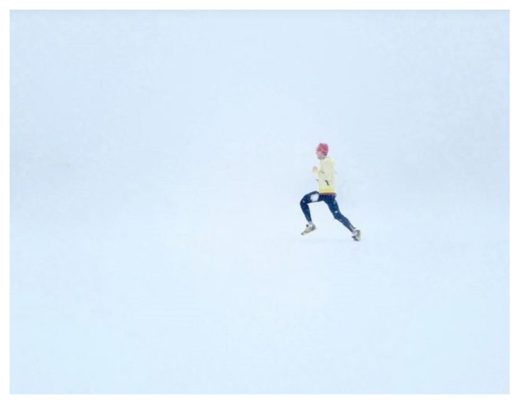
© Unsplash/Isaac Wendland
The World Health Organization (WHO) keeps tabs on every country's
HALE rating, which stands for "healthy life expectancy at birth." HALE is a measure of how long the average citizen will live before disease or disability sets in. Worldwide, that average is about 63 years. But according to the WHO's 2016 data, the residents of Japan know something the rest of us don't; the average Japanese citizen will live without disability until age 75 - nearly six years longer than the average American.
A mixture of diet, DNA, and lifestyle factors likely combine to explain this.
But cold-weather exercise may also be part of the equation. "Growing up in Tokyo, it was thought that winter training keeps you away from the doctor, and the Japanese often exercise in winter," says
Shingo Kajimura, an associate professor and lab director at the University of California, San Francisco (UCSF). "We can see now this makes a lot of sense."
Kajimura's
lab at UCSF focuses on metabolism and energy balance, and specifically on the function of the body's fat cells. He says cold exposure during workouts may be beneficial for a number of reasons. For one thing, shivering burns a lot of calories. "Shivering is a very energy-demanding and tiring process," he says. If your goal when exercising is to lose weight, working out in the cold may help a bit.
Some of Kajimura's
research has also shown that spending time in cool or cold environments converts some of the body's fat cells from unhealthy "white" fat to heat-producing, metabolically active "beige" fat. Kajimura says this conversion seems to help the body acclimatize to cold environments and increases resting energy expenditure - the amount of calories a person burns just sitting around. Research by Kajimura
and others has shown that beige fat may limit blood sugar spikes and even combat metabolic disorders like diabetes. "For now, this is just a theory," he says. "We need more investigation."
Exercise
also appears to promote the development of beige fat. Kajimura says one hypothesis is that beige fat helps the body filter byproducts called metabolites that are released during exercise.
Evidence suggests certain metabolites can contribute to fatigue and post-exercise soreness. So, for a lot of reasons, "Combining cold stimulus with exercise is a great idea," he says.
"I highly recommend exercising outside in the early morning or swimming in cold water."Fat and fatigue benefits aside, cool-weather training may offer other perks. Maintaining proper internal temperature is one of the body's main priorities during any activity, says
Mike Jett, an instructor and lab director in exercise physiology at the University of Louisville in Kentucky. Exercise produces heat, which the body must labor to counteract if workout conditions are hot and humid. While that's not a big deal in most circumstances, it can hamper athletic performance. "If heat accumulates, exercise intensity is reduced," Jett says. Meanwhile, exercising in cool conditions (or even in cold ones, assuming you're properly bundled) seems to be optimal. The body can devote all its resources to training and performance, rather than to temperature regulation, Jett says. However, "Working out in an intentionally hot room does not make sense from a performance standpoint," he adds.
There may even be some mental health benefits associated with cold-weather exercise.
A small 2004 study from Finland found that winter swimming combatted tension and fatigue and improved overall well-being among 36 middle-aged adults. Cold-water exposure seems to activate the central nervous system and stimulate the circulation of hormones that may promote improved mood and energy, write the authors.
There are, of course, risks involved with cold-weather training - especially if you're training aggressively in frigid conditions. "Winter-sport athletes suffer from a high prevalence of airway dysfunction," says
Michael Kennedy, an associate professor of kinesiology, sport, and recreation at the University of Alberta in Canada.
Coughing, wheezing, trouble breathing, and mucus buildup in your throat are all signs of cold-induced lung trauma, Kennedy says. While you want to avoid these as much as possible, he says a sensation of burning in your lungs or a taste of blood in your mouth are your biggest concerns. These are indications of damage "deep in the lung" and may have long-term effects on lung health and function, he says. Unhealthy lung inflammation, scarring of lung tissue, and a kind of cold-induced asthma are all possible from exercising in freezing temps without proper protection, he says.
If you're training in temps below 40 degrees, you should take extra precautions to protect your lungs.
"Cover your mouth with a buff or some sort of quick-dry neck covering," Kennedy says. Also, don't go back indoors until your breathing has slowed to normal. "There is something called the burden of rewarming where, if your breathing is still elevated, it causes more water to be sucked out of the airway," he says. That can promote lung stress.
Cold-weather exposure may also be risky for people with heart disease. "When you're exposed to cold, the body tries to prevent heat loss by shrinking the blood vessels," Kajimura explains. This can elevate a person's blood pressure and could be bad news for someone with hypertension or heart trouble, he says.
But taken together, most of the research suggests that working out in cool or cold conditions is good for you. That doesn't mean you should be running in shorts and a T-shirt when it's 10 degrees out. If you're properly geared up and taking care to shield your lungs from too much dry, icy air, there's no reason to take your workouts indoors this winter.
Reader Comments
to our Newsletter